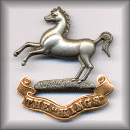















|
"The Story of the 9th King's in France"
THE FIRST DIVISION
Next morning the Battalion disembarked at Le Havre and marched to a camp at Sanvic. It was not to remain here long, and on the 14th the Battalion entrained to join the First Army. The train journey was long, and the men experienced for the first time the inconveniences of travelling in French troop trains, being crowded fifty six at a time into trucks labelled "Hommes 48: Chevaux en long 8." Chocques was reached on the 15th and the men marched there from to billets in a village close by called Oblinghem. The Battalion was soon incorporated in the 2nd Infantry Brigade of the 1st Division, a mixed brigade consisting of four Regular battalions reinforced by two Territorial battalions. A few days were spent in Divisional Reserve at Oblinghem during which time all the officers and several non-commissioned officers were sent to the trenches at Festubert or Richebourg for instruction by the Regular battalions which were holding the line.
At Oblinghem the men learnt for the first time what French billets were like and experienced the insanitary conditions prevailing on the small farms and the draughty and dirty barns. Looking around the countryside all seemed quiet and peaceful. The ploughman ploughed the fields, others sowed and the miners went to their daily tasks as usual. At times it was difficult to realise that the firing line was within a few miles, but the boom of the distant guns and the laden Red Cross motors indicated the proximity of the fighting. A lot of old ideas as to the rigours of a campaign were lost, and warfare in some respects was found not to be so bad as had been expected. Wine and beer at any rate were plentiful, though the potency of the beer was not quite sufficient for the taste of the older men. Other regiments, lent officers to give a helping hand in organisation and training. Company messes for officers were formed, as anything in the nature of a battalion mess was impracticable.
The men soon learnt that the estaminets were the equivalent in France of the public houses at home, and thither they repaired in the evening to spend their time. Many good young men who had never taken a drop of the more invigorating liquors learnt that soldiers drank them, and the cause of teetotalism began to wane.
On the 24th a move was made to Les Facons, a straggling village outside Bethune. Here on quiet nights one could easily hear the fusillade in the trenches while the distant gun flashes lit up the night sky. The terrors of the trenches were coming nearer.
Early in April the various companies were attached each in turn to another battalion in the Brigade, and went into the line for instruction in trench duty at Port Arthur by Neuve Chapelle, and it was here that the first casualties were sustained. It is claimed that the first shot fired by the Battalion killed an enemy sniper. The men soon learnt the duties that fell upon them as a consequence of trench warfare: the early morning stand to, the constant vigil of the neutral ground between the lines, and the imperative necessity of keeping one's head low. Hitherto the men knew little of the nature or use of guns, but now glimmerings of the mystery surrounding artillery fire soon dawned. The men learnt the natures of German shell, and the difference between shrapnel and high explosives and what targets the enemy generally selected. Facts like these were explained to them by the "real soldiers" of the Regular units to which they were attached. On relief the Battalion marched back to Oblinghem once more, where it stayed a week or two, and later in the month took over a portion of the line at Richebourg St. Vaast where it was subjected to a very heavy artillery bombardment on the 1st May.
The military training of the men can be said to have been complete as regards pre war standard, but the war had introduced the use of two new instruments of death. One was gas, the other the bomb. A primitive form of respirator was given out in consequence of the use by the Germans of chlorine at the Second Battle of Ypres. Instruction was given in the use of bombs, of which the men had hitherto no knowledge. In those days the bomb first in use was the jam tin bomb. The men were taught how to cut fuses, fix them into the detonator, attach the lighter and wire the whole together preparatory for use against the enemy. Jam tin bombs were soon discarded for the Bethune bomb, and there was no regular bomb until much later, when the use of the Mills bomb became universal. The Hairbrush and Hales bombs were also studied in addition to the Bethune. A few also received some instruction in a rather primitive form of trench mortar.
In April, Lieut. Colonel Lloyd, V.D., was invalided home, and in his stead Major T. J. Bolland took over the command of the Battalion.
|